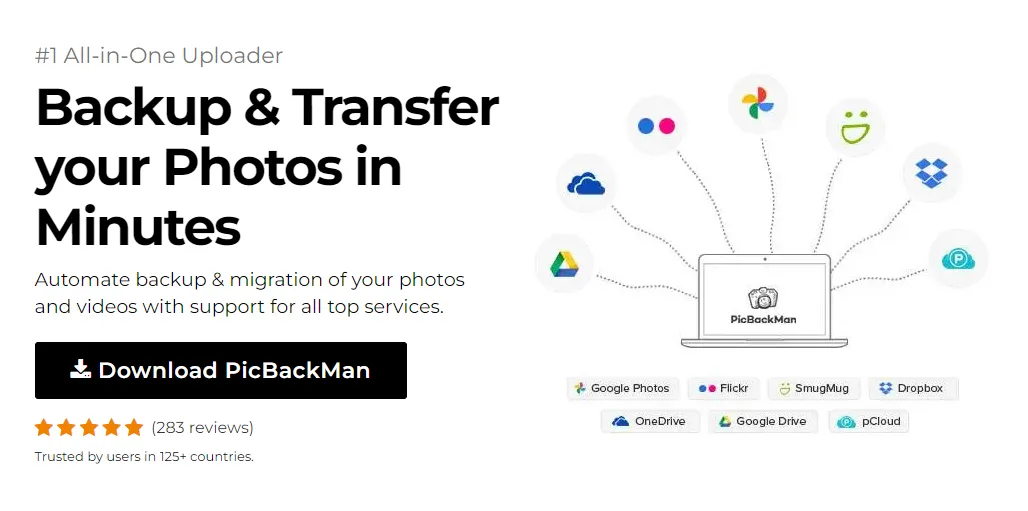Why is it the #1 bulk uploader?
- Insanely fast!
- Maintains folder structure.
- 100% automated upload.
- Supports RAW files.
- Privacy default.
How can you get started?
Download PicBackMan and start free, then upgrade to annual or lifetime plan as per your needs. Join 100,000+ users who trust PicBackMan for keeping their precious memories safe in multiple online accounts.
“Your pictures are scattered. PicBackMan helps you bring order to your digital memories.”
[4 FREE Ways] How to Use SharePoint to Share Files

Sharing files with your team shouldn't be complicated. If your organization uses Microsoft 365, you already have access to SharePoint, a powerful tool that makes file sharing simple and secure. The best part? You don't need to pay extra or be a tech expert to use it effectively.
In this guide, I'll walk you through four completely free ways to share files using SharePoint. These methods work whether you're collaborating with teammates, sharing documents with clients, or organizing files for a project. By the end of this article, you'll know exactly how to share any file through SharePoint with confidence.
What Makes SharePoint Great for File Sharing?
Before diving into the "how," let's quickly cover why SharePoint stands out for file sharing:
- It's already included in most Microsoft 365 subscriptions
- Files can be accessed from anywhere with internet access
- Multiple people can work on documents simultaneously
- You control exactly who can view or edit your files
- Version history tracks all changes automatically
- Strong security features protect your sensitive information
Now, let's explore the four free methods to share files in SharePoint.
Method 1: Direct File Sharing from SharePoint Libraries
The most straightforward way to share files in SharePoint is directly from document libraries. This method works perfectly when you need to share specific files with individuals or groups.
Step-by-Step Guide to Direct File Sharing
Step 1: Access Your SharePoint Site
First, log into your Microsoft 365 account and navigate to SharePoint. You can do this by clicking the app launcher (the waffle icon) in the top left corner of any Microsoft 365 application and selecting SharePoint.
Step 2: Navigate to the Document Library
Once in SharePoint, go to the site containing the file you want to share. Click on "Documents" or the specific library where your file is stored.
Step 3: Select the File to Share
Find the file you want to share and click the three dots (ellipsis) that appear when you hover over the file name. This opens a dropdown menu with various options.
Step 4: Click the Share Option
From the dropdown menu, click "Share." This opens the sharing panel where you can set permissions and add people.
Step 5: Add People and Set Permissions
In the sharing panel, type the names or email addresses of the people you want to share with. You can also add a message to explain what you're sharing.
Next, decide what level of access to grant:
- Can edit: Recipients can view, edit, and delete the file
- Can view: Recipients can only view the file but not make changes
Step 6: Send the Invitation
Click "Send" to share the file. Recipients will get an email with a link to the file and any message you included.
Tips for Direct File Sharing
- You can share multiple files at once by selecting them all before clicking the share button
- Check "Notify people" if you want recipients to receive an email notification
- Use the "People in [your organization]" option for more secure internal sharing
- You can stop sharing at any time by returning to the sharing panel and removing access
Method 2: Creating and Sharing Links to Files
Sometimes you need to share files with many people or through channels like chat or email. Creating shareable links is perfect for these situations.
How to Create and Share Links to Files
Step 1: Select Your File
In your SharePoint document library, select the file you want to share by clicking on it once.
Step 2: Click the Share Button
Click the "Share" button at the top of the page. This opens the sharing panel.
Step 3: Choose Link Settings
Instead of adding specific people, click "Anyone with the link" or one of the other link options:
- Anyone: Creates a link that anyone can use, no sign-in required (use with caution)
- People in your organization: Only people in your company can use the link
- People with existing access: Only people who already have access can use this link
- Specific people: Only people you specify can use the link
Step 4: Set Permission Level
Choose whether link users can edit or only view the file. For sensitive documents, "View" is often safer.
Step 5: Set Expiration and Password (Optional)
For extra security, you can set an expiration date for the link and even add a password.
Step 6: Copy and Share the Link
Click "Copy link" and paste it wherever you need to share it - in an email, chat message, or another application.
When to Use Link Sharing
Link sharing works best when:
- You need to share with many people at once
- You want to share in platforms outside of Microsoft 365
- You need to include the file in documentation or instructions
- You want people to access the file without email notifications
Method 3: Sharing Entire Document Libraries
If you're working on a project requiring access to multiple files, sharing an entire document library saves time and keeps everything organized in one place.
Steps to Share a Document Library
Step 1: Navigate to the Library
Go to the SharePoint site containing the document library you want to share.
Step 2: Open Library Settings
Click the gear icon in the top right corner and select "Library settings."
Step 3: Access Permissions Settings
Under "Permissions and Management," click "Permissions for this document library."
Step 4: Share the Library
Click "Share" at the top of the page. A sharing panel will appear.
Step 5: Add Users and Set Permissions
Add the people or groups you want to share with. Then select the appropriate permission level:
- Full Control: Complete access to manage the library (use sparingly)
- Edit: Can add, edit, and delete files
- Contribute: Can add and edit files but not delete them
- Read: Can only view files without making changes
Step 6: Send the Invitation
Click "Share" to send the invitation. Recipients will get an email with a link to the library.
Benefits of Sharing Entire Libraries
- Saves time when sharing many files at once
- Automatically grants access to new files added to the library
- Creates a collaborative workspace for teams
- Makes project management more efficient
- Ensures consistent permissions across related documents
Method 4: Using SharePoint Teams Integration for File Sharing
If your team uses Microsoft Teams, you can leverage the built-in SharePoint integration for seamless file sharing within your collaboration spaces.
How to Share Files Using Teams-SharePoint Integration
Step 1: Open Microsoft Teams
Launch Microsoft Teams and navigate to the team where you want to share files.
Step 2: Go to the Files Tab
Click on the "Files" tab at the top of your team channel. This actually shows the SharePoint document library connected to your team.
Step 3: Upload or Create Files
You can upload existing files by clicking "Upload" or create new files directly in Teams by clicking "New."
Step 4: Share Within the Team
Files uploaded here are automatically shared with all team members based on their team permissions. No additional sharing steps needed!
Step 5: Share Outside the Team (Optional)
To share with people outside your team:
- Click the three dots next to the file
- Select "Share"
- Follow the same link or direct sharing process described in Methods 1 and 2
Advantages of Teams-SharePoint Sharing
- Files are automatically available to all team members
- You can discuss files directly in the same channel
- Changes to files trigger notifications in the channel
- Teams and SharePoint permissions stay synchronized
- You can access files both in Teams and SharePoint
Comparing the 4 SharePoint File Sharing Methods
| Sharing Method | Best For | Ease of Use | Security Level |
|---|---|---|---|
| Direct File Sharing | Sharing specific files with individuals | Very Easy | High (precise control) |
| Link Sharing | Sharing across platforms or with many people | Easy | Medium (depends on settings) |
| Library Sharing | Project teams needing access to multiple files | Moderate | High (consistent permissions) |
| Teams Integration | Ongoing team collaboration | Very Easy | High (team-based security) |
Best Practices for SharePoint File Sharing
To get the most out of SharePoint file sharing while maintaining security, follow these best practices:
Organize Files Logically
Create a clear folder structure before sharing. This helps recipients find what they need without confusion. Consider creating separate libraries for different departments or projects.
Use Descriptive File Names
Name your files clearly so recipients immediately understand what they contain. Include relevant information like project names, dates, or document types.
Apply the Principle of Least Privilege
Only grant the minimum access level needed. If someone only needs to view a document, don't give them edit permissions.
Regularly Review Sharing Permissions
Set a schedule to review who has access to your files. Remove permissions for people who no longer need them, especially after projects end.
Use Expiration Dates for External Sharing
When sharing with people outside your organization, set link expiration dates so access automatically ends after a certain period.
Communicate What You're Sharing
When sharing files, include a brief message explaining what you're sharing and what action you expect from the recipient.
Train Your Team
Make sure everyone understands how to share files securely. A quick training session can prevent accidental oversharing.
Troubleshooting Common SharePoint Sharing Issues
Even with a straightforward tool like SharePoint, you might encounter some hiccups. Here's how to solve common problems:
Recipients Can't Access Shared Files
If people report they can't access files you've shared, check:
- Whether they're signed in with the correct account
- If they have the necessary permissions
- Whether the link has expired
- If external sharing is enabled for your site (for external users)
Solution: Verify their email address and resend the invitation or create a new sharing link.
Files Are "Read-Only" When They Should Be Editable
This usually happens when:
- The permission level is set to "View" instead of "Edit"
- Someone else has the file checked out
- The file is open in desktop app by another user
Solution: Check the sharing settings and update permissions if needed. If the file is checked out, contact the person who has it checked out.
Changes to Shared Files Aren't Visible
If changes don't appear to save or aren't visible to others:
- Refresh the browser page
- Check if you're editing the correct version
- Ensure changes were actually saved
Solution: Close and reopen the file, or check version history to see if your changes were saved as a new version.
Too Many People Have Access to Sensitive Files
If you've accidentally overshared:
- Go to the sharing settings for the file
- Review the list of people with access
- Remove unnecessary permissions
- Disable any "Anyone" links
Solution: Update sharing settings immediately and consider creating a new version of the file with proper permissions.
Extending SharePoint File Sharing Capabilities
While the four free methods cover most sharing needs, you can enhance SharePoint's capabilities with these additional features:
Using SharePoint Mobile App for On-the-Go Sharing
Download the SharePoint mobile app to share files from your phone or tablet. The process is similar to the desktop version but optimized for touch screens.
Setting Up Alerts for Shared Files
Create alerts to get notified when shared files change:
- Select the file
- Click "Alert me" from the top menu
- Choose your notification frequency and delivery method
- Click "OK"
Creating Views to Organize Shared Files
Custom views help organize large libraries:
- Go to library settings
- Click "Create view"
- Choose a view type and customize filters
- Save your view
Using Flow for Automated Sharing
Microsoft Power Automate (Flow) can automate sharing processes:
- Automatically share files when they're added to specific folders
- Send reminders about shared files
- Notify managers when sensitive files are shared externally
Quick Tip to ensure your videos never go missing
Videos are precious memories and all of us never want to lose them to hard disk crashes or missing drives. PicBackMan is the easiest and simplest way to keep your videos safely backed up in one or more online accounts.
Simply download PicBackMan (it's free!), register your account, connect to your online store and tell PicBackMan where your videos are - PicBackMan does the rest, automatically. It bulk uploads all videos and keeps looking for new ones and uploads those too. You don't have to ever touch it.
Conclusion
SharePoint offers four powerful, free methods to share files with teammates, clients, and partners. Whether you prefer direct sharing, link creation, library sharing, or Teams integration, you now have the knowledge to choose the right approach for your specific needs.
Remember that effective file sharing balances accessibility with security. By following the best practices outlined in this guide, you'll keep your information both available to those who need it and protected from those who don't.
Start implementing these methods today, and you'll quickly see how SharePoint can transform your file sharing experience from complicated to streamlined. Your team will thank you for making collaboration easier, and you'll save time that used to be spent on email attachments and version confusion.
Frequently Asked Questions
1. Is SharePoint completely free with Microsoft 365?
Yes, SharePoint is included with most Microsoft 365 business and enterprise subscriptions at no extra cost. If your organization has Microsoft 365, you likely already have access to SharePoint without needing to pay anything additional.
2. How do I know who has access to my shared files?
To check who has access to a file, select the file in SharePoint, click "Share," and then click "Manage Access" in the sharing panel. This shows a complete list of everyone with access and their permission levels, allowing you to add or remove people as needed.
3. Can I share files with people who don't have Microsoft accounts?
Yes, you can share with external users by creating "Anyone" links that don't require sign-in. However, your SharePoint admin must enable external sharing for your organization first. For better security, you can also require recipients to verify their identity with a one-time passcode sent to their email.
4. What's the maximum file size I can share through SharePoint?
SharePoint Online supports files up to 250GB in size. However, for optimal performance, Microsoft recommends keeping file sizes under 100GB, especially when sharing with multiple users. Very large files may take longer to upload and download depending on internet connection speeds.
5. Can I track if someone has viewed my shared file?
Yes, SharePoint provides basic analytics for shared files. Select your file, click the "..." menu, and choose "Details" to see view statistics. For more comprehensive tracking, you can enable versioning in library settings, which records when files are viewed and modified and by whom.






